|
Chapter 6
PERU - CHILE
Pisco - Nasca - Arequipa - Colca Canyon - Santiago
from
the lees of the grapes like Eau de Vie and Grappa and can be made from
various different grapes. Most
of the explanation was in Spanish and some in English but I could just
about follow it.
Julie
and I then moved inside for the tasting.
The wine was sweet and thick but it was interesting, although
somewhat deadly, to taste the different types of Pisco.
Needless to say I preferred the most expensive one so I bought a
bottle of that to take home. We
had to wait outside the bodega for a taxi to take us back to the main
road. Carlos wanted to learn English and insisted I had his card so I
could write to him in English and he would reply in Spanish!
We
caught a Lima bus home to Ica which was very new and comfortable.
They were showing a Sandra Bullock film “While you were
sleeping” in English with Spanish subtitles and I was quite content to
sit in comfort and watch the film.
In
Pisco Julie went home to change before going to work and I met up with
Jen (she had spent the day at Paracas again and was picked up by an
Italian group who insisted she stayed with them).
We visited Julie’s travel agency to try and book a trip to
Nasca for tomorrow. There
were no seats available on any of the buses passing through Pisco.
Sunday
26 July
We
took an early bus to Ica and waited several hours for a bus to Nasca.
In the bus station Jen opened her birthday present (a small jug
from Cusco) and we amused the rest of the passengers with our birthday
celebrations.
When
we alighted, a chap looked at our tickets and loaded our rucksacks into
his ancient American car. Two
others joined us and we were taken to an aerodromo.
There is one airstrip on the outskirts of Nasca and several
little airline offices (huts) along the edge of it, each has its own
small plane. We had to wait
for a while (as usual) and watched a video of the lines and Maria Reiche.
She worked at Nasca almost continuously from 1946 to her recent
death. She believed that
the lines were an astronomical calendar, linked to the rising and
setting points of celestial bodies on the east and west horizons.
It was then explained to us that this company could not take us
for a flight as we had a ticket for a different company! We protested that we had showed our tickets to the chap who
had picked us up but it was all very good humoured and someone from the
correct company came to collect us in a much more modern car.
We
returned to Nasca town and, whilst waiting for our real flight,
attempted to book our onward transport to Arequipa.
All the buses were full. At
the fourth bus company they said they could get us a seat at 2200
tonight. We were driven
back to a different airline office and had a great flight over the lines
in a six seater, four gringos, one guide and one pilot.
It
is interesting to note how many of the extended lines are extremely
straight. One theory claims
that they were made using cane poles and a rope, in much the same manner
as a surveyor uses ranging sticks and a theodolite; when Maria Reiche
first came to Nasca some of the locals could indeed remember wooden
poles at the end of certain lines - perhaps sighting posts for the
stars. How long it took to
construct them is a last, inevitable question - and since none of them
can be properly seen from the ground it is tempting to believe they must
have been the skilled product of numerous generations.
In strictly physical terms this isn’t necessarily so.
A few years back a local school tried building its own line and
from its efforts calculated that a thousand patient and inspired workers
could have made them all in less than a month!
Jen remonstrated with the pilot for looking round at us and not
looking where he was going and he replied by showing the plane could
still fly without him touching the controls.
We were unfortunately unable to take any photographs.
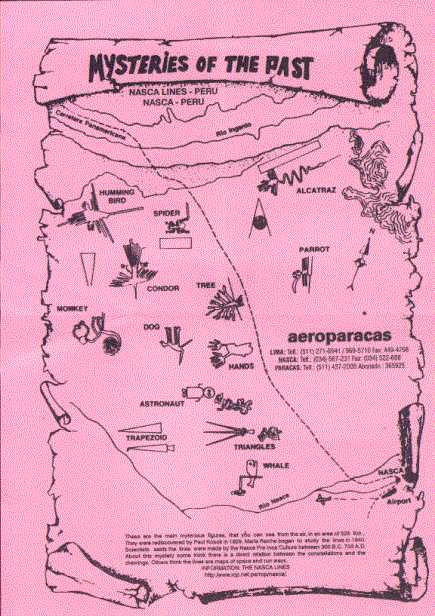
We
had all evening to wait for the bus and explored the town.
This didn’t take long. All
the souvenirs involved representations of the individual patterns which
make up the lines. We were pestered by young shoeshine boys, even though we were
wearing sandals, and Jen attempted to put them off by offering to kiss
them. They stayed out of
range but were still very persistent.
We
waited at the travel agent’s office for the 2200 bus. At 2145 one stopped but it was full. We moved to the bus office, a few doors up the road, and
waited for the next one. The
bus office was actually someone’s sitting room and kitchen.
There were zillions of buses pounding up the road but none had
the right name until 0200 when an ancient coach with some spare seats
stopped and we were off to Arequipa.
Monday
27 July
We
arrived in Arequipa at 1030. That
might have been our last long distance bus trip.
The name probably comes from the Quechua phrase “Are quepay”
meaning “OK, let’s stop here”.
Sited at the foot of an ice-capped volcano “El Misti” the
place has long been renowned for having one of the most pleasant
settings and climates of all Peru’s cities.
Everyone
was gearing up for the Independence Day celebrations. We arranged a trip to Colca Canyon for the next day for S30 (£8.11)
staying overnight in Chivay and I bought a cheap camera.
The processions and fireworks that evening were viewed
magnificently from the restaurant on the upstairs balcony at the Plaza
de Armes. After the
fireworks (they were very good at fireworks) there were speeches and
then music and dancing (on stage anyway - more chaps in shiny suits with
bells on their boots). No-one
in the square danced except for one drunken Peruvian who danced, very
badly, with Jen. We were
most disappointed. There
were the usual food vendors and also tables and chairs where you could
sit and drink. But drink what? The
choice was either Anis or a concoction of rum and what looked like hot
tea, mixed together and very sweet, drunk from a cup.
Well I had to try it didn’t I?
Tuesday
28 July
The
next morning we waited in the sun on the roof of our hostel for the
TurBus to Chivay. The bus
was full of Peruanos from Lima with one French couple and one other
English couple. Our guide,
Joanna, was at university in Arequipa learning to be a teacher and this
was her holiday job. We
were travelling around the top edge of the Atacama desert and the
similarities to the desert at San Pedro were obvious.
The bus had to stop for photographs when we saw a couple of vicuñas
in the distance but Jen and I had seen it, done it.
We stopped in Yanque to see its early eighteenth century chapel
and later in Maca where their church had suffered in the last
earthquake.
On
the way up the Canyon there were various miradors (lay-bys with a good
view) overlooking some of the most impressive and intensive ancient
terracing in South America - when the Incas arrived it had all been
done!
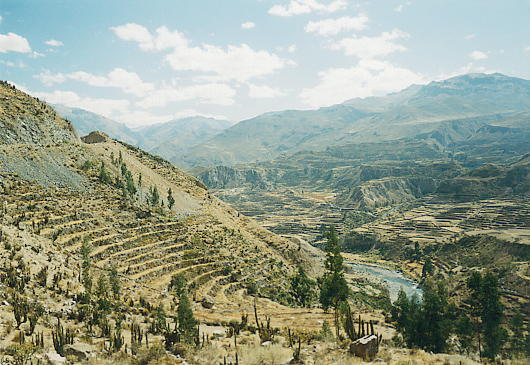
Impressive
terracing!
Jen
and I had a modern room on the second floor of a modern hotel in Chivay
and lunch was spoilt for me because I had forgotten the “no smoking,
no drinking” rule when first at altitude.
I had been on the coast for so long I had lost my immunity. My forehead was clammy and the darkness started coming in so
I went to lie down before I fainted.
Jen cancelled my lunch (that was a bit hasty!) and visited me
later complete with a glucose tablet from one Lima lady (good for
altitude sickness), a cup of coca tea recommended by several of our
travelling companions and a cheese sandwich made from rock hard white
bread and the wonderful Peruvian cheese (just as good as Chilean
cheese!) which tasted like rubber.
I was feeling fine by now but couldn’t refuse all these gifts.
We
sat on the balcony in the sun looking at the mountains until it was time
to go to the thermal baths at La Calera.
These were only a short distance away and consisted of lots of
hot water pouring down the hillside in concrete drains and pipes and at
least two modern swimming pools at the bottom.
We were allowed half an hour in the baths and stayed for longer.
We returned to the hotel for dinner and were entertained
afterwards by a panpipe band and dancing, after which Jen went to the
local hop with some of the Lima girls.
Wednesday
29 July
Our
day for visiting Colca Canyon which claims to be the deepest canyon in
the world at more than 1km from cliff-edge to river bottom.
The Mirador Cruz del Condor, located some 200km and five hours
from Arequipa, is a popular viewing place for looking into the depths of
the canyon - it’s around 1200m deep at this point - and where you can
almost guarantee spotting a condor or two circling against unbelievably
breathtaking scenery. There
were many vehicles at the top and people crawling all over the rocks.
We were told to keep quiet so as not to frighten away the condors
but when one was spotted a whisper went through the crowd.
We could see young condors, with brown plumage, and mature ones
with black and white plumage but they were a long way away.
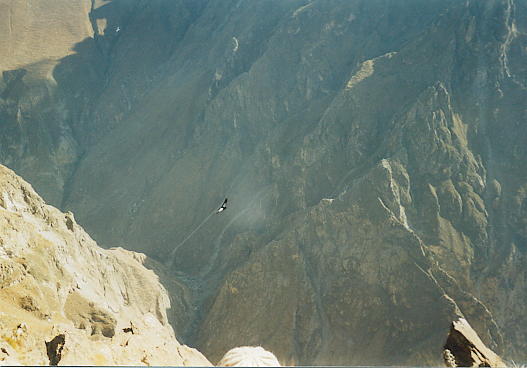
The
little black and white blob in the middle is a condor!
I
was slightly worried that someone would fall down into the canyon as
there were people clambering down very insecure slopes.
There was an amazing togetherness within our crowd after such a
short time. All the young
Peruvians were very touchy, feely and wished to practise their English. There were also local women in traditional dress selling
cacti fruit and other comestibles.
We tried as many as possible and they were mainly very good. One woman had an eagle (?) on a rope and was happy to be
photographed.
We
were driven back down the edge of the canyon and stopped at a different
mirador from where you could see the Inca graves high on the cliff.
Little stone bundles that hang underneath overhanging rock like
bees nests. How on earth
did the Incas get there to build them? Apparently they are not so little, they have more than enough
room for a mummy (albeit short!). We
stopped at the highest point of the pass on the way back where the
ground was covered with piles of stones.
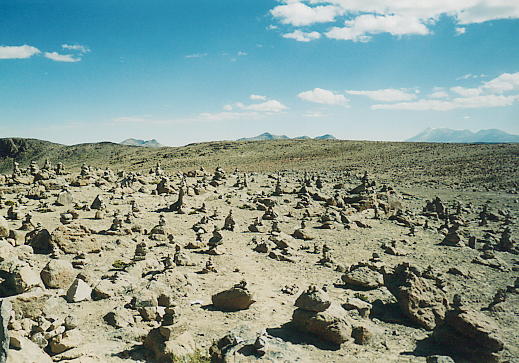
They
were wishes stones. You
build your own tower from the many loose stones available and make a
wish. “I would like to
visit Peru again.” Will
it work I wonder? As the
road was a dirt track it was very dusty and there was mucho traffic -
all these tourists (I can’t say gringos because they were mostly
Peruvian) taking tours to Colca Canyon.
Back
at Arequipa there were kisses and hugs at parting. We exchanged addresses with Marlene who insisted we stay with
her and her husband in Lima next time we visit Peru.
Jen
and I walked back up the hill to the Hostal Nunez where we had to spend
S55 (£14.86) on a room with four beds, a private bathroom and a
television because that’s all they had available.
Jen and I loved rooms with more than two beds because we could
spread our stuff around and it was easier to pay up than find another
hostel.
Thursday
30 July
The
next morning we headed for the market because the book said they sold
hats. I was particularly
enamoured with the black stetson style hats some of our panpipe band at
Chivay were wearing. Unfortunately
Peruanos, as well as being short, have very small heads and there were
none that fitted me.
In
the afternoon we visited the Monastery of Santa Catalina which housed up
to 500 nuns in seclusion up until its opening to the public in 1970.
Nuns still live there but they are restricted to one quarter of
the site, worshipping in the main chapel only outside of opening hours.
The idea of being a cloistered nun was an anathema to Jen and I
but we appreciated the interplay between the strong sunlight and the
brilliant colours of the stonework (!).
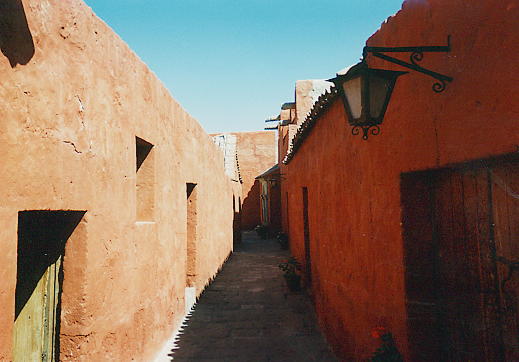
It
wouldn’t have been a bad place to live apart from the god bothering.
We returned to our hostel to sun ourselves on the roof until it
was time to go to the airport. Fortunately the Hostal Nunez also ran a taxi service.
It
was a 30 minute flight to Tacna and dark by the time we took off.
Arequipa, like most Peruvian cities, has streets in straight
lines. Flying away into the
night I could see the lights of the city below me, looking just like a
beautiful Christmas decoration. By
the time we arrived it was late and our taxi driver tried to take us
somewhere cheap but they were full.
He then tried to take us somewhere expensive but we were used to
cheaper prices so we walked off to find somewhere slightly less
expensive ourselves. It was
difficult. We later read in the guide book that Tacna is very expensive
compared to the rest of Peru.
Friday
31 July
Jen
was in a bad mood as she was woken by the dual sounds of television and
children screaming at an early hour and there was no hot water (like
last night). What are we
paying these expensive prices for?
She hotfooted it downstairs to complain but the management were
uninterested although they did turn the television off and stopped the
children screaming. Gagged
them presumably.
We
took a bus to the “terminal” and were pounced on by collectivo
drivers. Arica?
Arica? The first one
that nabbed us seemed fine and we ended up, having paid S0.40 (11p) for
the privilege of being in the “terminal”, sitting in his ancient
Dodge saloon outside waiting for some more customers.
We were just beginning to get restless when our driver returned
with a family who wished to go to Arica too.
It
was an hour’s drive with two stops - Peruvian exit and Chilean entry.
At one of them (I don’t know which) we had to pass through a
small cubicle where two women were searching the women travellers for
drugs. A gringo!
The woman to whom I was assigned really enjoyed going through my
bag and my pack and thoroughly investigated every item as well as me.
Jen was somewhat luckier and the locals passed through
unhindered.
In
Arica we remembered the travel agent with the cheapest Santiago flights
and walked down to book one. There
was a flight at 1900 that night so we decided to take it. In Santiago we directed the taxi to the youth hostel as,
although it was late, we knew they were open 24 hours a day. Fortunately they had beds or they would have after midnight.
We were given two beds in a four bedded dormitory with a locker
each.
Saturday
1 August
A
whole day in Santiago to ourselves and we now knew the city.
We knew how the metro operated and started by visiting the
funicular. Unfortunately
that’s all we could do as the funicular was closed for the winter.
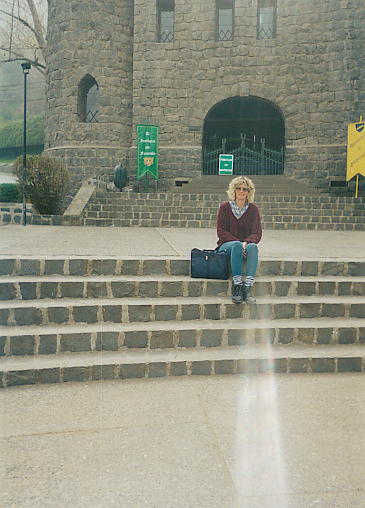
We
returned to the main shopping area and went shopping. The winter coats in one shop were very attractive but
although they were cheap they were all too small.
We passed the boutique with the wonderful suits that I had
noticed the first time in Santiago and ...
The Givenchy boutique - beautiful suits and coats at amazing
prices. Jen and I fell upon
them like people who have spent the last six weeks living in dirty and
creased T shirts and leggings. Jen
tried on a Givenchy trouser suit which she really fancied and I had
found a mid-calf red winter coat. We
had no money but I had a Barclaycard and we were smitten.
Plans were hatched for an amazing night out on my last day.
Jen
was complaining about the hairiness of her legs to the sales assistant
so, having spent heaps of money, the assistant guided us over the road
to a small hairdressers where they also did leg waxing.
Bliss! Beautiful
smooth legs with no pain and a very small amount of
pesos.
By now we were hooked. We
needed lipstick, every woman here wears lipstick, mascara and I needed
ear-rings. Jen also needed
shoes because her trouser suit needed heels and she didn’t bring any
with her. What a mistake.
The
Youth Hostel was full of girl guides.
Apparently guiding is quite a strong movement in Chile.
These guides were from Hertfordshire? Lancashire? I can’t
remember. Exchanges are
arranged with guides in other countries and they were spending three
weeks touring around southern Chile.
Guiding was never like that when I was a child or I might have
been more interested!
Sunday
2 August
We
took a day off from shopping to explore the countryside.
A metro to Parque O’Higgins led to a bus to San Jose de Maipo.
From there we found a collectivo to San Alfonso.
The driver of the collectivo pointed out ex-President
Pinochet’s house to us. After
that we had to hitch. Our
first lift in the back of a Chevrolet pickup took us on to the next
village. We were following
a map given to us by the Tourist Information in Santiago and heading for
some thermal baths. Baños
Morales or Baños Colinas, we didn’t mind which.
Our
next lift was in a Suzuki Vitara with Kurt, a topographer.
He was happy to give us a lift to Baños Morales but when we got
there he said he was going on up the valley and if we wanted to stay
with him he would give us a lift back to Santiago.
No contest. On the
way he mentioned Baños Colinas and said it was a very bad road.
This was all in Spanish. I
thought this meant we weren’t going there but it turned out we were
going there, along the bad road.
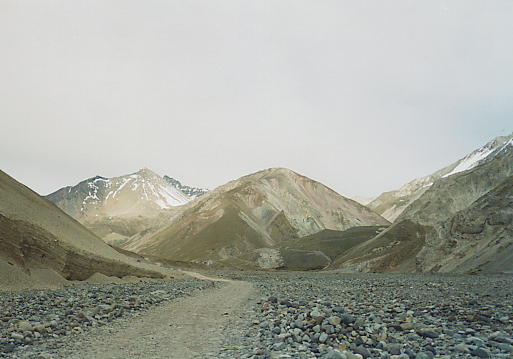
And
it was bad. It was another
dirt track, missing in places, with wet bits and dangerous bits, all the
time overlooked by mountains in magnificent colours.
Kurt delighted in telling us where people had died on this road.
At the end we had to pay P2500 (£3.57) to enter the Baños
Colinas car park (which Kurt paid) and then we had three pools in the
hillside, three or four feet full of hot water.
He was not going to bathe but Jen and I changed in a tiny cubicle
and leapt in. As usual I
had forgotten my bathers but I had Jen’s sports top and my shorts
which matched very well. The
water was murky but very warm and we were instructed by one of the
locals to take the mud from the bottom and plaster it over our faces and
bodies. Not a gringo in
sight, just what we liked.
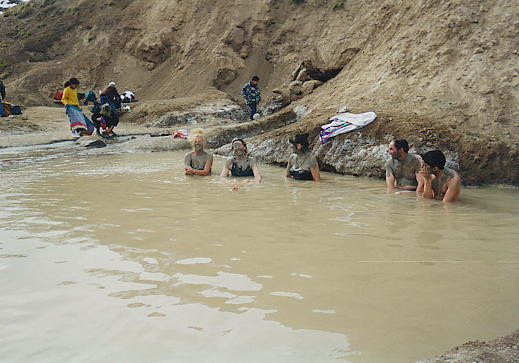
Kurt
drove us home with a short stop at the fossil shop as he and Jen were
both into stones. They did
not wish to buy any, however, fossils have to be found not bought.
We also drove down to Baños Morales, just for a look, and then
the two of them could not resist going for a short fossil hunt.
We
had to battle with the Santiago rush hour to get home.
That evening we all went for a Chinese meal and, to say thank
you, invited Kurt to join us for our binge tomorrow.
He comes from a large family, was it six brothers and seven
sisters or the other way around? He is the only one working in Santiago, all the rest of the
family are still in Puerto Varas, more than 1000km to the south.
He accepted.
Monday
3 August
A
day for more shopping - all the bits we couldn’t find the day before
yesterday and time to have my boots cleaned again, P500 (£0.66) this
time. We ended up having
coffee at the fish market and the chap we met before came over to see
how our holiday had been. He
could see before he asked that we had had and were still having a
wonderful time. We spent
the afternoon trying to find a noisy, lively restaurant for that night.
Our book suggested a restaurant not far from the hostel which
provided good food and local music.
Without too much difficulty we found the place and went in for a
look. An extremely grumpy
waiter showed us around. Although
the menu looked fine we were not sure that there would be any music and
dancing so decided to try and find somewhere else.
Despite ringing several times I could not get hold of Stefano (my
winery contact in Santiago). Having trawled through our guide book and another guide to
Santiago supplied by the Youth Hostel, I asked the chap in reception
where he would recommend for music and dancing.
Not a question he had to answer very often it appeared! He
could only suggest an area of the city where the nightlife was hottest.
We dressed up and stunned the rest of the Youth Hostel with our
transformation. Don’t
they ever go dancing, these people?
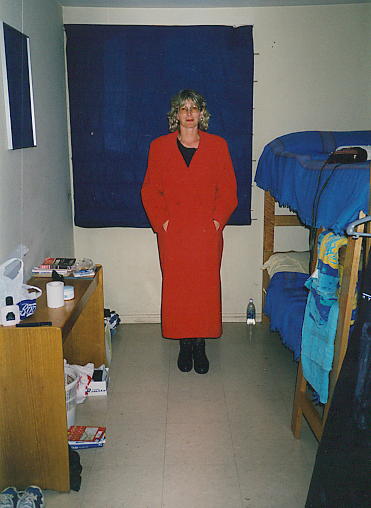
We
finally decided on a restaurant up at Providencia, near the Embassy,
because there were places to dance there too.
Kurt volunteered to drive. In
the restaurant, Jen and I ordered but Kurt was uncertain what to have.
He asked Jen to choose something for him and when his meal
arrived it was wrapped in fancy paper with ribbons.
Kurt was a little embarrassed! Jen
decided this was the one night when she would partake of a little
alcohol, we each ordered a Tom Collins.
Not a good choice for someone who doesn’t really drink as it
was gin, gin, more gin with a little bitter lemon.
The waiter spoke perfect English which was handy as, after the
meal, he advised me on the nearest and best places to dance.
We tried the discotheque almost next door and danced the night
away.
Tuesday
4 August
I
was slightly the worse for wear after our celebrations last night (it
must have been finishing Jen’s Tom Collins!) so the day started slowly
and quietly. The collectivo
was booked for 1230 and with an hour to go we went out for a last coffee
at the stew and beetroot cafe. We
arrived back at the Youth Hostel at the right time and waited, talking
to an American about our travels. At
1300 one of the the youth hostel guardians, who looked remarkably like a
gorilla, rang the collectivo office for me, they knew nothing about
collecting me but promised to send someone shortly.
Within 15 minutes I had said goodbye to Jen, gathered up all my
bags and left for the airport.
At
the airport I trawled the souvenir shop looking for something on which
to spend my last pesos but there was nothing I fancied.
I ended up giving them to BA for their “Change for Children in
Africa” appeal which I suppose was only just.
Without their problems I would not have visited South America in
the first place. Thanks BA
and thank you Tavern!!
Top of page
Home |